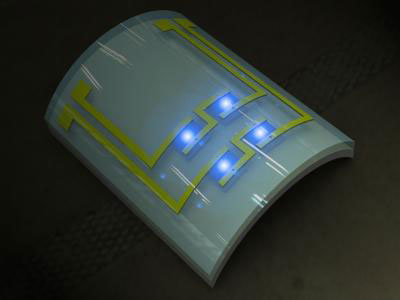|
|
|
|
 News Feeds News Feeds
|
 Join us on Facebook Join us on Facebook
|
 Follow us on Twitter Follow us on Twitter
|
|
? Posted: Sep 19th, 2011 Posted: Sep 19th, 2011 Posted: Sep 19th, 2011 Posted: Sep 19th, 2011 Posted: Sep 19th, 2011 Posted: Sep 19th, 2011 Posted: Sep 19th, 2011 Posted: Sep 19th, 2011 Posted: Sep 19th, 2011 Posted: Sep 18th, 2011 Posted: Sep 18th, 2011 Posted: Sep 18th, 2011 Posted: Sep 17th, 2011 Posted: Sep 16th, 2011 Posted: Sep 16th, 2011 Posted: Sep 16th, 2011 Posted: Sep 16th, 2011 Posted: Sep 16th, 2011 Posted: Sep 16th, 2011 Posted: Sep 16th, 2011 |
| Posted: Sep 19th, 2011 | |
| Cancer detection from an implantable, flexible LED | |
| (Nanowerk News) Can a flexible LED conformably placed on the human heart, situated on the corrugated surface of the human brain, or rolled upon the blood vessels, diagnose or even treat various diseases? These things might be a reality in the near future. | |
| The team of Professor Keon Jae Lee (Department of Materials Science and Engineering, KAIST) has developed a new concept: a biocompatible, flexible Gallium Nitride (GaN) LED that can detect prostate cancer. | |
 |
|
| The team of professor Keon Jae Lee (Department of Materials Science and Engineering, KAIST) has developed a new concept: a biocompatible, flexible gallium nitride (GaN) LED that can detect prostate cancer. | |
| GaN LED, a highly efficient light emitting device, has been commercialized in LED TVs and in the lighting industry. Until now, it has been difficult to use this semiconductor material to fabricate flexible electronic systems due to its brittleness. The research team, however, has succeeded in developing a highly efficient, flexible GaN LED and in detecting cancer using a flexible LED biosensor. | |
| Prof. Lee was involved in the first co-invention of "High Performance Flexible Single Crystal GaN" during his PhD course at the University of Illinois at Urbana-Champaign (UIUC). This flexible GaN LED biosensor utilized a similar protocol to transfer thin GaN LED films onto flexible substrates, followed by a biocompatible packaging process; the system's overall potential for use in implantable biomedical applications was demonstrated. | |
| Watch a video on the flexible GaN LED for implantable biomedical applications: | |
| Professor John Roger (Department of Materials Science and Engineering, UIUC) said, "Bio-integrated LEDs represent an exciting, new technology with strong potential to address important challenges in human health. This present work represents a very nice contribution to this emerging field." | |
| This paper was published in the online issue of Nano Energy Elsevier Journal (Editor, Prof. Zhong Lin Wang) dated September 16, 2011. |
?
?
Source: http://www.nanowerk.com/news/newsid=22785.php
united airlines continental airlines myrtle beach cna delta airlines up sdc
No comments:
Post a Comment
Note: Only a member of this blog may post a comment.